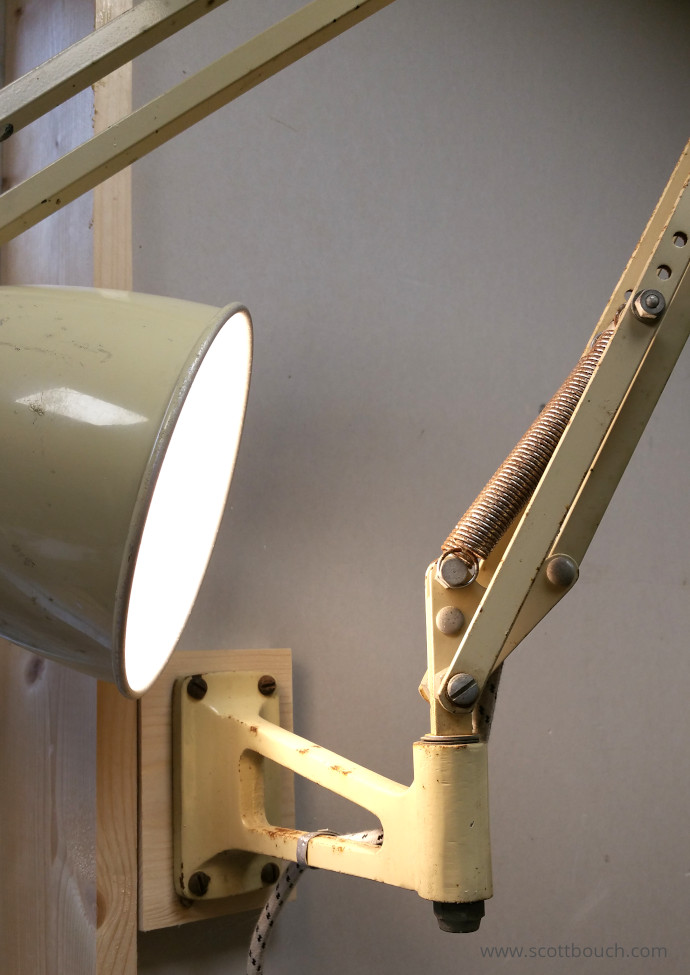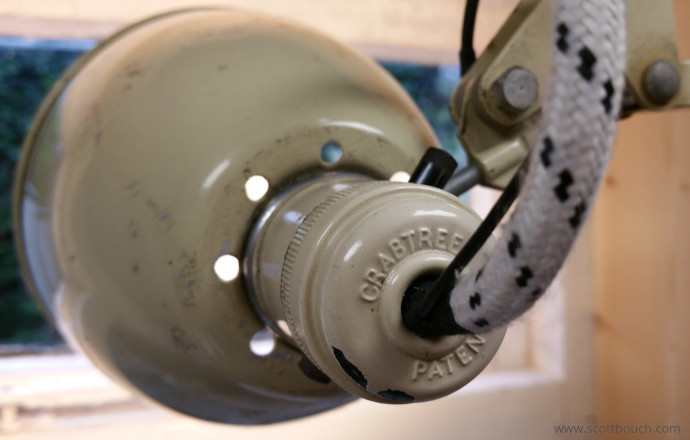Herbert Terry & Sons Ltd;
The "Anglepoise" Lamp
For as long as I could remember, this lamp had been fitted to a window frame at the back of my Nana's garage (June Law, nee June Woodford). When she sadly passed away, this was one of the items of the house clearance that nobody had paid particular interest to, and was heading for the tip; until I rescued it thinking it'd be nice to use in my garage as she had done. She had used it above a bench grinder / polishing mop.
She came from a dentistry family, where her father operated a dental technicians lab from home. She later managed a dental supplies depot, Hawley & Yates Ltd, 101 London Road, Leicester. She joined Hawley & Yates in 1941, and her first job was to clear up broken glass from the depots shattered windows after a bomb was dropped on Saxby Street. Hawley & Yates were later taken over by S.S. White and in 1962 moved premises to a haunted house in Regents Road... as a child I remember my Nana telling me stories about "Bella" the Victorian ghost who would pass by customers coming up the stairs leaving them confused about seeing a lady dressed in Victorian attire; and other stories about knocking stock items off the shelves at night.
Amongst supplying almost every piece of equipment a dental lab could need, one of her jobs was the valuation of used equipment when a lab had gone out of business and needed to sell up.
This lamp may have been from her father's home dental lab (my great grandfather), or one of the labs she valued, or perhaps was new stock 'disappeared' from the depot, we will never really know.

A few years after her passing, in 2021 I eventually got round to dusting it down and installing it in my garage. I showed it to a friend and mentioned I may re-paint it, he instantly recognised it's historical interest and recommended I do my research into it (thanks Bear) first. It turned out not only to be a nice family memory, but a symbol of inter-war era designer style.
Identification
One distinct feature of this lamp that marks a difference between it and most Anglepoise lamps commonly found online, is the lack of the tall central post for spring mounting. This feature has helped me identify this lamp in the adverts see below.


This exact model is missing form the timeline on anglepoise.com, so as of yet I can't identify its model number or years of production.
Dating
In trying to date it, I have found a couple of adverts which show this exact model with short central post, and similar looking pivot brackets. The nature of these adverts is aimed more toward workshop machinists, rather than office use; the adverts for office based lamps mostly show other models with the tall central post such as the models 1208 and 1227 seen in the Anglepoise timeline (linked above).

Image credit: aviationancestry.co.uk, Flight magazine 02-12-1937
This 1954 advert details the wall mounting bracket of this lamp as an option.

Image credit: aviationancestry.co.uk, Aviation Engineering 09-1954
Sympathetic Restoration
Literally a wipe down with a damp cloth removed most of the dust / grime it had acquired over the years from illuminating the polishing mop & grinder.
As this lamp has lived in a damp garage for a significant part of its life, there are areas of surface corrosion, which I am inclined to leave alone as they tell part of its own story. I was tempted to give it a rub down and re-spray before I realised it's historic significance, but my friend's advice on it soon put a stop to those ideas.
Adding to the interest, was the original Crabtree switched bulb holder. Most Terry Anglepoise lamps on Bay have had the bulb holders replaced at some point in their past (presumably they may crack due to heat cycles), so I was delighted to find the original intact and still in serviceable condition!

In my teens I had re-wired this lamp for my Nana as the original rubberised 2 core flex had fallen to pieces and was on the least favourable side of average, however, the PVC cable I had installed some 20+ years prior was now also showing signs of age and too, for safety's sake, had to go.
As can be seen in the advertising images, this lamp should have a round section cable, which agrees with my distant memories of the initial re-wire years ago. But I decided to rewire it again with a cotton braided cable from a scrap domestic iron, electing for this as it has a mid-century feel to it, and is slightly prettier than just a black rubber cable, but it maintains the round section of the original cable. Most lamps seen for sale use a very pretty style cable formed of two braided cores twisted together, I was tempted to go down this route, but what stopped me was that this lamp would not have had that type of twisted pair cable originally.
The old iron cable was 3 core, allowing for an Earth connection, so I added a ring solder lug to the lamp under a bolt head at the end of the arm, thus adding an additional layer of electrical protection that most lamp's don't offer. This is evident by the thin black wire visible in the photos between the lamp holder and the arm end bracket.
I gave it a low power LED bulb, which also nicely ties in with one of the original 1930's advertising philosophies of reducing power consumption.
Current Use
The unfortunate COVID19 pandemic has resulted in our house becoming occasionally occupied with children home-schooling due to classroom outbreaks. In order to quietly concentrate on my work I have been spending a lot of time working on my laptop at the garage workbench where this lamp is now installed, so recently it has been in daily use illuminating my workspace, potentially about 60 or 70 years or so on from when it was first in daily use!